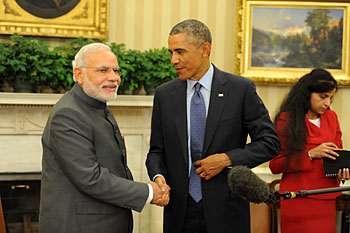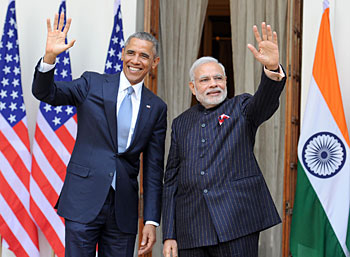INDIAN ARMED FORCES CHIEFS ON OUR RELENTLESS AND FOCUSED PUBLISHING EFFORTS

SP Guide Publications puts forth a well compiled articulation of issues, pursuits and accomplishments of the Indian Army, over the years

"Over the past 60 years, the growth of SP Guide Publications has mirrored the rising stature of Indian Navy. Its well-researched and informative magazines on Defence and Aerospace sector have served to shape an educated opinion of our military personnel, policy makers and the public alike. I wish SP's Publication team continued success, fair winds and following seas in all future endeavour!"

Since, its inception in 1964, SP Guide Publications has consistently demonstrated commitment to high-quality journalism in the aerospace and defence sectors, earning a well-deserved reputation as Asia's largest media house in this domain. I wish SP Guide Publications continued success in its pursuit of excellence.
Indo-US Defence Ties
India and the US share strategic objectives and one area in which in there is positive convergence between the two nations is the rising threat from China.
 |
By Air Marshal B.K. Pandey (Retd) Former Air Officer Commanding-in-Chief of Training Command, IAF |


In the recent past, China has become increasingly belligerent in the East and South China Sea and she has also been making blatant attempts to assert her sovereignty over the areas claimed. This has not only been a matter of serious concern but has also caused a degree of alarm for the countries in the region especially Vietnam, Philippines, Malaysia and Indonesia, apart from India. But what is relevant for India is that China’s aggressive posture has also provided an impetus to the emergence of a new alignment of nations more appropriately described as a power block, in the Asia-Pacific region consisting of four nations namely the United States (US), Australia, Japan and India. While this development ought to be of equal concern to China, as for India, there are some uncertainties that continue to nag the newly crafted Indo-US strategic partnership.
Only a few decades ago, the relationship between the US and India was not very cordial; in fact, it was somewhat hostile. The US always supported Pakistan which was for all practical purposes an ally, providing it with military hardware including modern combat aircraft that were used against the Indian forces in the Indo-Pak war of 1965. Six years later, the US Navy sent an aircraft carrier into the Indian Ocean in an attempt to intimidate India during the war with Pakistan in 1971 for the liberation of Bangladesh.
Recent history of Indo-US relations have also been plagued by some turbulence. Before being elected as the Prime Minister of India in May 2014, Narendra Modi was persona non grata in the US as he was carrying the baggage of the carnage during the riots in Gujarat in 2002. During this sordid episode which was essentially a violent reaction to another equally horrendous carnage, a large number of members of a particular community were slaughtered in mob violence. Narendra Modi was the newly installed Chief Minister of Gujarat at that time and was regarded by many as being responsible for the mayhem. In fact, the US government at that time had then decided not to grant him a visa, should he have applied for one.
However, post the land-slide victory by the BJP during early 2014, there was a perceptible change in the scenario. Experts in international relations were of the view that the results of the election would bring about a radical change in the Indo-US relations. And they were right, at least to some extent. The fact that President Barack Obama was the first President of the US to be invited as the Chief Guest at the Republic Day Parade at Delhi on January 26, 2015, may have appeared to some to be a symbolic gesture of mere cosmetic value, but in fact, it did help send a clear message of a new beginning in Indo-US friendship and the mutual intent to take the relationship between the largest and the oldest democracies in the world, to a new level.
India and the US do share strategic objectives and the one area in which in there is maximum and positive convergence between the interests of the two nations is the rising threat from China. The recent economic turmoil notwithstanding, China is a regional power and is racing ahead of India both economically and militarily clearly striving to be a superpower to challenge the position of the US on the global scene. Combating the menace of terrorism is another area where the interests and priorities of India and the US are congruent. On the economic front, the US views India as a lucrative market for investments provided the political leadership is able to set the house in order. India on the other hand, eyes the regime of high technology the US has to offer both in the military and non-military sectors of the industry as also collaboration in the field of nuclear power generation to ensure India’s energy security in the years to come.
But today, the continued support of Pakistan by the US is a major irritant and in fact a stumbling block in the effort by India to strengthen ties with the US. What makes the context somewhat incongruous is the fact that while Pakistan is virtually an ally of China which is inimical to both the US and India, the US continues to provide liberal economic and military aid to Pakistan. The most recent episode is the plan by the Obama administration to sell to Pakistan eight Lockheed Martin F-16 Block 52, the most advanced version of the legendary combat platform, ostensibly to combat terrorism, an alibi somewhat difficult to digest by even the most gullible. This deal is to be financed partially by an economic aid package that has also been planned for this year. This decision by the Obama administration has been opposed not only by India but by members of the US Congress as well.
While both India and the US harbour great hopes of propelling their strategic partnership to unprecedented levels, there is a lurking danger that the Pakistan factor may well subvert the efforts and aspirations of the two nations. And China will leave no stone unturned to spoil the party!





